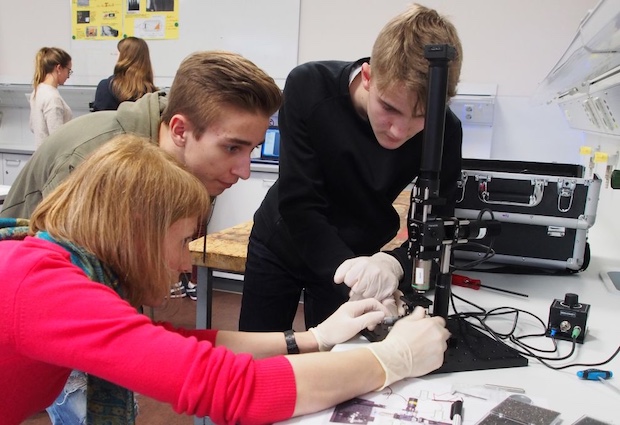
Building microscopes to learn biology
How EMBL’s ‘Microscope in Action’ introduces teenagers to the basics of fluorescence microscopy

A small group of pupils have gathered around a low table. In front of them, a wild mix of metal parts, electronic devices, optical equipment, and a laptop are scattered around. Fingers are pointing, hands are moving individual parts, strategies are being discussed and dismissed a moment later. The teenagers are about to build their own fluorescence microscope.
One vision
“It’s amazing to see how quickly they’re figuring out how things can be put together to make up a microscope,” says Agnes Szmolenszky, Head of EMBL’s European Learning Laboratory for the Life Sciences (ELLS). Together with EMBL group leader Robert Prevedel, Agnes and her team have devised the teaching programme ‘Microscope in Action’. At the centre of it is a modular fluorescence microscope simple enough for teenagers to assemble, yet delivering research-grade images of biological specimens.
The idea for the do-it-yourself microscope dates back a few years. Robert had recently joined EMBL and was discussing novel educational approaches with Agnes. He showed her the modular microscope he had developed for teaching microscopy to PhD students, and was excited by Agnes’s suggestion to extend the concept to a younger audience. With help from Giulia Paci, then a PhD student in the Lemke group, and Ling Wang, who works with Prevedel, the ELLS team figured out how to adapt the microscope so that it could be used by teenagers from the age of 15 onwards.
A star is born
The pilot phase took the microscope to workshops at a school in Heidelberg. The teenagers were fascinated. “It inspires even pupils who have not been involved in experimental biology before. The unique experience is putting together the microscope by yourself – not seeing it being put together for you,” Agnes explains. Word about the microscope spread among EMBL scientists, and Agnes started receiving requests for it to be made available for courses and scientific retreats as well. “That was when we realised its full potential,” she says.

First tests in the field were encouraging, too. The microscope travelled to an outreach event in Rome and became part of a microscopy workshop held in Medellín, Colombia. “The pupils there were super-creative and suggested new activities for the microscope,” Agnes recalls. “The biggest challenge was to get it through customs as carry-on luggage,” she adds with a laugh. Further plans involve making the microscope available across EMBL’s sites and in the EMBL member states, where it could be used as an educational resource in schools and universities, or be involved in outreach activities. “We will take it forward step by step,” says Agnes.
Into the great wide open
Ultimately, Agnes and her team have even more ambitious goals. A new programme is in preparation, which will allow local teachers to borrow a microscopy kit for use in their classes, free of charge. The team regularly offers on-site training courses at EMBL Heidelberg in both German and English, to familiarise teachers with the microscope project. Additionally, all technical and educational material will be made available on the ELLS website. The microscope will come with a set of prepared biological specimens and instructions for learners on how to prepare further samples. Agnes hopes to make the kit available later this year. “We want to make sure we have a scheme that makes the microscope accessible to as many schools and pupils as possible,” she explains.
Fluorescence microscopy is such an important technique in the life sciences that everybody should have an opportunity to see and use it.
Development does not stop here. Agnes hopes that teacher and pupil communities will form to develop the approach further. Together with experts at EMBLEM, EMBL’s technology transfer partner, the ELLS team is planning to make the microscope widely available to schools and universities for purchase. “I’d like our microscope resource to become a common classroom activity,” Agnes concludes. “Fluorescence microscopy is such an important technique in the life sciences that everybody should have an opportunity to see and use it.”


